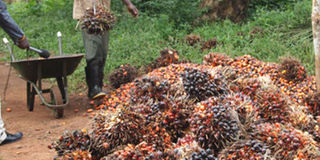Govt secures 2,000 hectares for Masaka oil palm project

A farmer harvests palm fruits. The commodity has become a key source of livelihood for the people of Kalangala District. PHOTO / FILE
What you need to know:
- According to Mr Saul Kityo, the focal person for Masaka oil palm project, the secured land is in all the four sub-counties of Masaka District; Kyanamukaaka, Buwunga, Bukakkata and Kyesiiga.
The government has secured 2,000 hectares of land in Masaka District for oil palm growing .
Oil palm growing in Uganda is already taking place in the island districts of Kalangala and Buvuma where government is growing the crop on nucleus estates and selected pieces of land owned by out growers.
According to Mr Saul Kityo, the focal person for Masaka oil palm project, the secured land is in all the four sub-counties of Masaka District; Kyanamukaaka, Buwunga, Bukakkata and Kyesiiga.
He said at least 700 out growers with at least one to five acres have so far been selected to benefit from the project aimed at expanding the edible oil industry in the country.
“Our target is 4,000 hectares, mainly on the shores of Lake Victoria but we have so far got 2,000 hectares. We could have started the project on the available land but we are still waiting for an approved environmental impact assessment report, which will possibly be ready by September,” Mr Kityo said in an interview on Saturday
He said they prioritised areas on the lake shores because of their conducive climate and easy transportation of crude oil palm using water vessels to the processing plant in Jinja.
In addition to seedlings, Mr Kityo said out growers will be provided with fertilisers on loan and they will pay back at the time of harvest.
“One needs about 60 oil palm seedlings per acre and keeping other factors constant, the first harvest is expected after three years where he can earn at least Shs7 million on average from one acre per annum,” he added
Currently, Uganda produces at least 40,000 tonnes of oil palm but the ministry of Agriculture through the National Oil Palm Project (NOPP) strives to increase it to 80,000 tonnes in the coming few years.
Mr Nathan Lujumwa, the chief administrative officer for Masaka District, said the project comes with benefits ranging from payment of taxes to employment for youth and women.
“Palm oil production, if well supported would be an opportunity for not only Masaka District, but also the neighbouring districts in this sub-region. First, as a source of employment for our people especially the youth, and
also boost industrialisation,” he said.
“It will also boost the economy through local revenues, which will return enhance service delivery,” he added.
Government had a plan to introduce oil palm growing in Masaka in 2001 but the project faced a lot of resistance from local politicians, saying it would degrade the environment, which prompted government to relocate it Kalangala Islands.
THE BIGGER PICTURE
Since the advent of oil palm growing in the country in 2005, Kalangala has been enjoying the monopoly of cultivating the crop where more than 10,000 hectares of trees have been planted, with 6,500 hectares operated by NOPP while 3,500 hectares belong to out growers. Under the second phase of the project which covers Buvuma Islands, the government also plans to extend oil palm growing to other districts such as Masaka, Kyotera , Buikwe and Mukono. The second phase of the project will be funded at a tune of $210m (about Shs767b), which the government secured from International Fund for Agricultural Development (IFAD).




